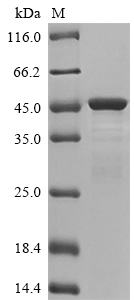Recombinant Human Keratin, type I cytoskeletal 19 (KRT19) is expressed in E. coli and includes the complete protein sequence from amino acids 1 to 400. The protein carries an N-terminal 6xHis tag that helps with purification and detection steps. SDS-PAGE analysis shows purity levels above 85%. This product is intended for research use only, with endotoxin levels below detectable limits, making it suitable for various experimental work.
Keratin 19 appears to be a type I intermediate filament protein that's central to maintaining structural integrity in epithelial cells. The protein participates in cytoskeleton formation and has become a standard marker in cancer research, particularly because of its presence in epithelial tissues. Studies examining cell structure and cancer diagnostics often rely on understanding how KRT19 functions and what it interacts with.
Potential Applications
Note: The applications listed below are based on what we know about this protein's biological functions, published research, and experience from experts in the field. However, we haven't fully tested all of these applications ourselves yet. We'd recommend running some preliminary tests first to make sure they work for your specific research goals.
Human KRT19 is a type I intermediate filament protein that requires precise folding, proper heterodimerization with type II keratins (e.g., KRT8), and specific coiled-coil formation for its structural function in cytoskeleton assembly. The E. coli expression system cannot provide the eukaryotic folding environment or the necessary partner keratins for correct heterodimerization. The N-terminal 6xHis-tag may sterically interfere with the protein's head domain, which is critical for filament assembly. While the full-length protein (1-400aa) contains all domains, the probability of correct folding with functional filament-forming activity in the absence of type II keratins is extremely low.
1. Antibody Development and Validation Studies
This application is highly suitable as antibody development relies on antigenic sequence recognition rather than functional protein folding. The full-length protein provides comprehensive epitope coverage for generating antibodies against KRT19. The high purity (>85%) ensures minimal contamination-related issues during immunization protocols.
2. Structural and Biochemical Characterization
These studies are essential for determining folding status, but will not reflect native heterodimer properties. Techniques like circular dichroism can assess secondary structure content, but results will describe a monomeric keratin rather than the physiological heterodimer. The His-tag may interfere with native structural features.
3. Epitope Mapping and Immunoassay Development
This application is well-suited for developing detection assays. The full-length protein serves as an excellent standard for epitope mapping and immunoassay optimization, as these applications depend on linear epitope recognition rather than functional conformation.
Final Recommendation & Action Plan
The E. coli-expressed KRT19 is suitable for antibody development but has significant limitations for functional studies. The protein cannot be used for filament assembly as it requires co-expression with type II keratins. Interaction studies and structural studies require careful validation and are limited to monomeric characterization. For reliable KRT19 research requiring native filament formation, co-express with partner keratins in eukaryotic systems that support proper heterodimerization and filament assembly.






